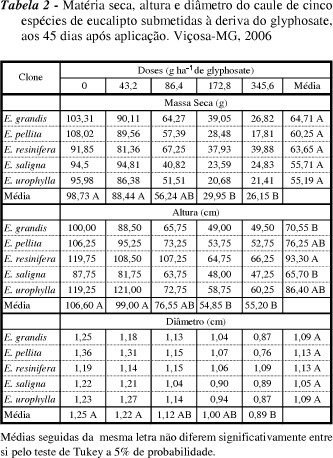Glyphosate is the most used herbicide in eucalypt plantations. In these areas intoxication symptoms are often observed due to glyphosate drift. However, research works and field observations indicate different behaviors among eucalypt species and clones with glyphosate contact. This work aimed to evaluate the effects of simulated glyphosate drift, by means of herbicide subdoses, on the growth of five eucalypt species. The factorial model used five species (Eucalyptus urophylla, E. grandis, E. pellita, E. resinifera and E. saligna) and five subdoses (0, 43.2, 86.4, 172.8, and 345.6 g ha-1 glyphosate) arranged in a randomized block design, with four repetitions. Glyphosate applications were performed on the plants in such a way as to avoid reaching the upper third part of the plants 23 days after seed planting. The intoxication symptoms caused by glyphosate were similar for the different species, as characterized by wilt, chlorosis and leaf curling and in the case of larger doses, by necrosis and leaf senescence. Plants treated with subdoses above 86.4 g ha-1 glyphosate were severely intoxicated and were affected in their growth, with smaller height, diameter and less dry matter after 45 days of herbicide application. Among the species studied, E. resinifera showed to be the most tolerant to glyphosate drift, displaying the lowest intoxication values and greatest height and diameter increases, a fact not observed in the other species.
Eucalyptus spp.; herbicide; tolerance




